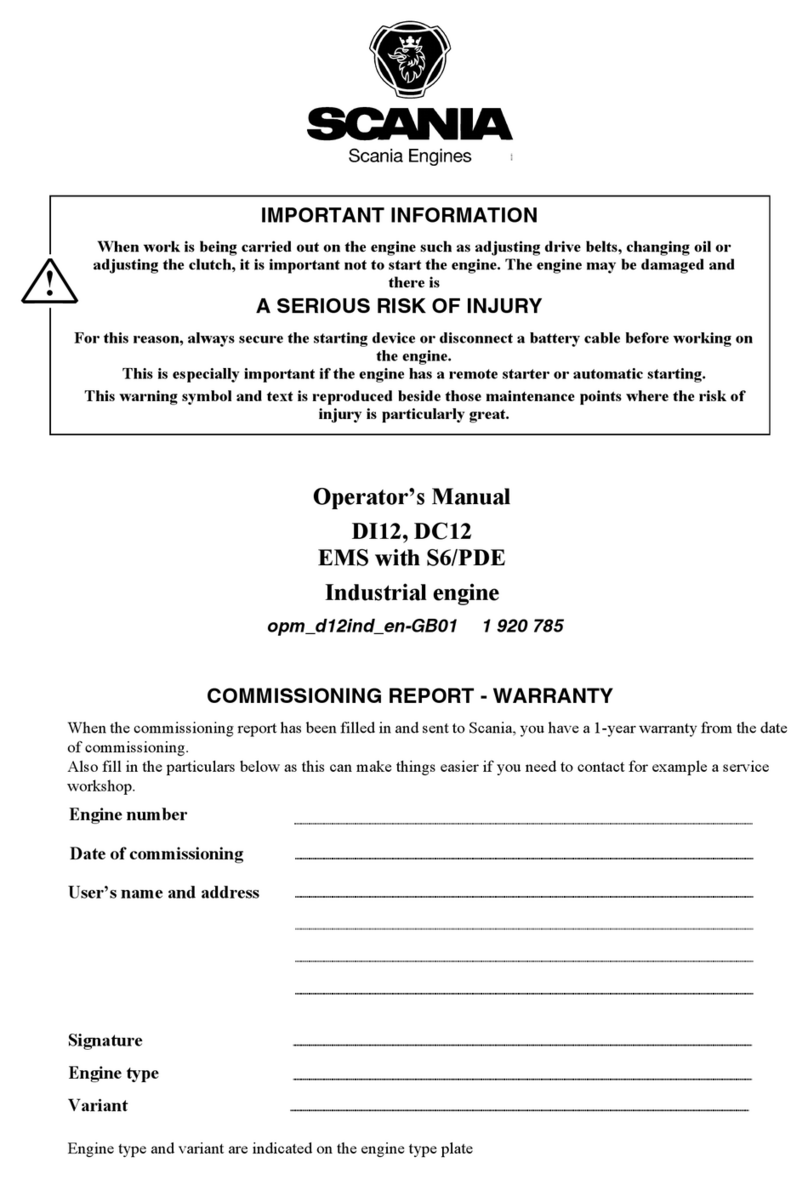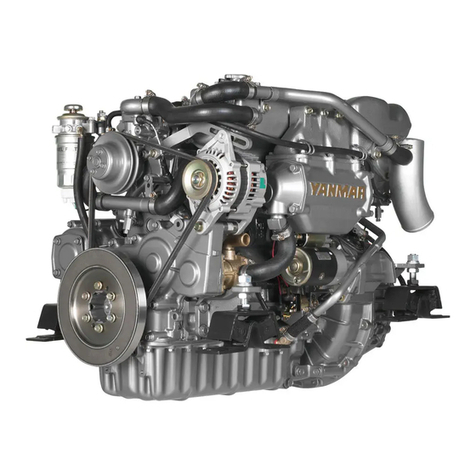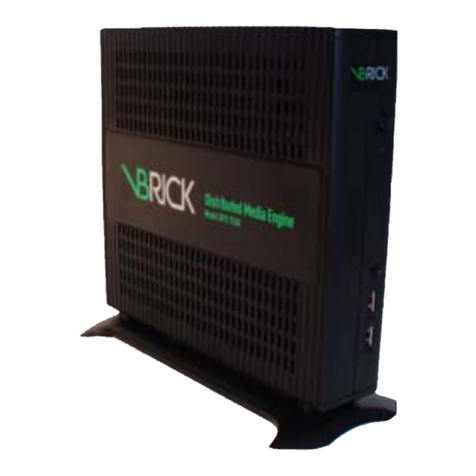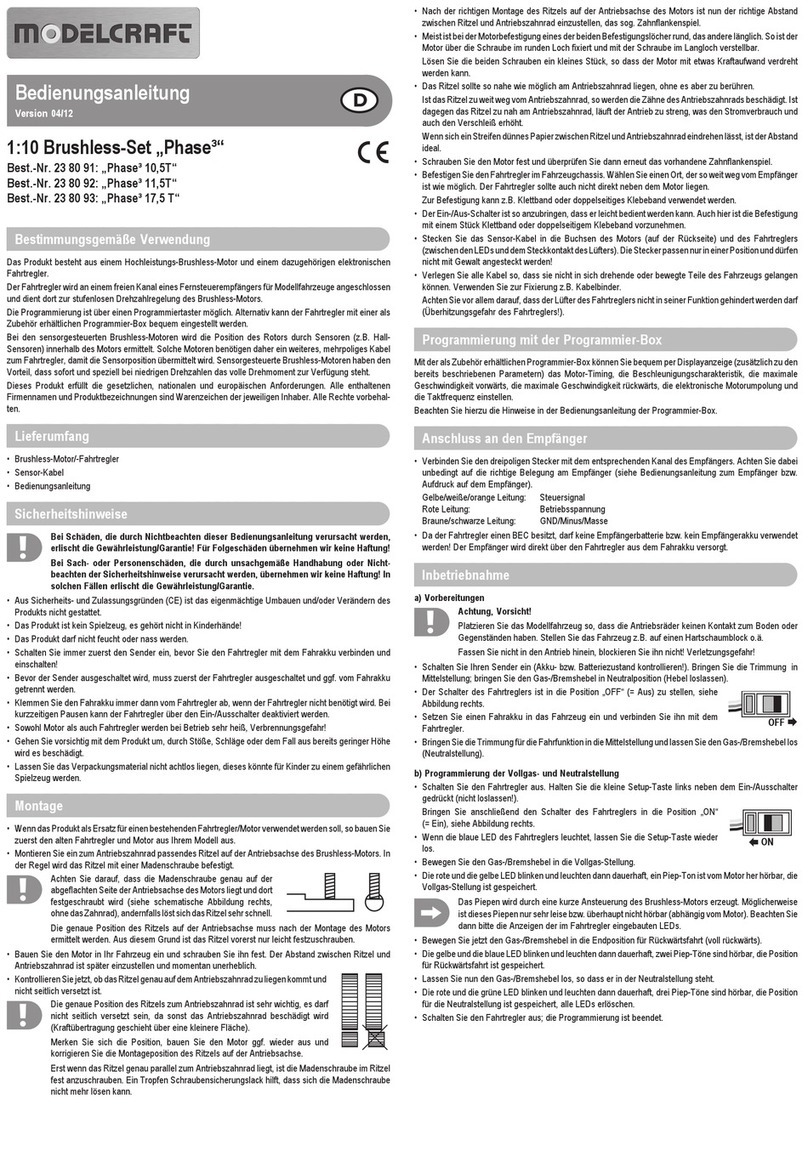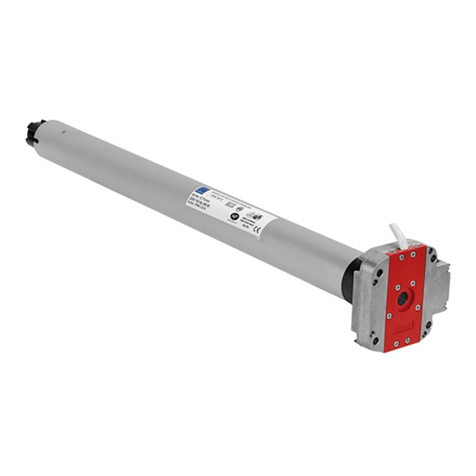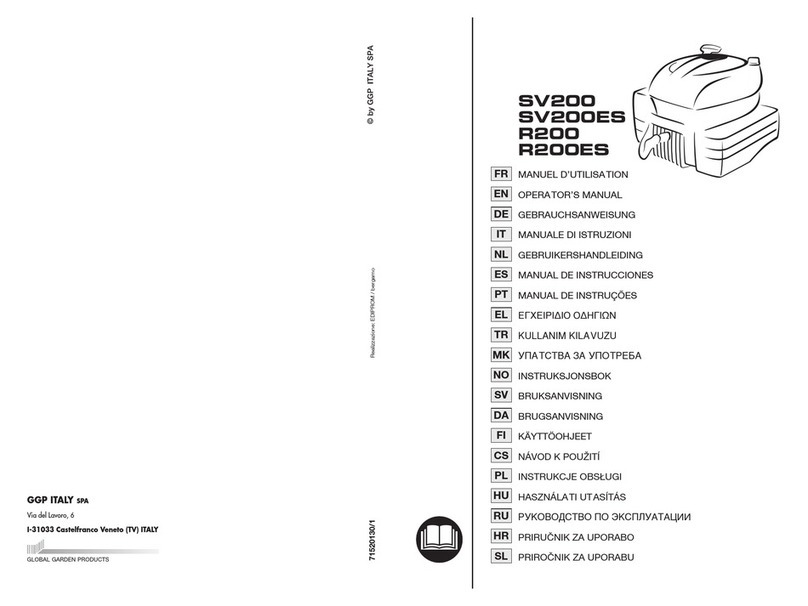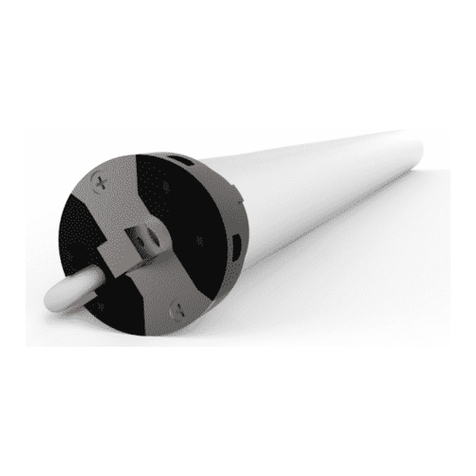Thornycroft 90 User manual


BS 5514/1.
MARINEENGINES
TheThornycroft90 and108enginesareboth4cylinder,4stroke naturally
aspirated high speed diesel units,bothengines having electrically operatedheater
plugstoaid cold starting.
The castiron crankcase withribbedsidewalls housesa forgedsteel, fully
counterbalanced crankshaftcarried in threeorfivebearingsrespectively.
Afull pressure wetsump lubrication system is employed with a full flow
detachable elementtype oilfilterandintegratedlubricating oil cooler.
Thecooling system isindirectandusually employsan engine mountedheat
exchanger with abeltdriven rawwaterpump.This system isknown asIFWC
(internalfresh water cooled).
An optional system isEFWC(externalfresh water cooled.)This systemutilizes the
enginefreshwaterpumpandusuallyemploys skin tanksattachedtothehulltoserveasheat
exchangers.
Thesinglebeltdrivenalternatorandfreshwaterpump drive includeamanual
belt tensioningarrangementforlowmaintenancecompletes thecomprehensive
engine package.
90108
4Cylinder naturallyaspirated 4Cylinder naturallyaspirated
Powerintermittent at3500rpm =36BHPPower intermittentat3500rpm= 47BHP
continuousat
3000rpm =30BHPcontinuous at 3000rpm =38BHP
Maximumtorqueat 2400rpm =731bf ft
Maximum torque
Idle speed at
2500rpm = 531bf ft
=570rpm Idlespeed=570rpm
Minimum full loadspeed = 1500rpm
ENGINERATINGS
Minimumfullloadspeed=1500rpm
The type 90Enginemay be settodevelopcontinuous outputs from13.5to 30 BHPaccordingto
requirements
The type108 Enginemay be setto developcontinuousoutputs from 21to 38BHP
according to requirements.
Forspecial applicationswherefull power willnotberequiredforperiodsin
excess of 1hourinany12 hoursconsecutiverunningtheenginecanbe suppliedatan
intermittent ratingas shown above.
NOTE:All horsepower ratings quotedare attheengine flywheel.Dueallowancemust
be madefor transmissionlosseswhichwilldependonthetypeofgearboxfitted.
Fortropicaluseit isnecessarytoderate theengine by2% foreach 5%°C(10°F)
above 30°C(85°F) airtemperature atsea level. Insome parts oftheworld
furtherderating for humidityis necessaryinaccordance with

INITIAL STARTINGOFENGINE
PAGE
_.Engine mountinganddipstick marking.Fillingengine withoil.
2. Lubricant specificationfor engineand gearbox. Fillinggearbox.
3.Coolant/Corrosioninhibitor specification. Filling coolingsystem.
4. Primingthe engine oilsystem.
5.Bleeding the fuel systemtype90engines.
6.Bleeding the fuel systemtype108 engines.
7. Initial start. Normal start. Running in.
8. Operating guidelines.
9.Operating guidelines.
MAINTENANCE
Maintenanceschedule.
Engine oil and filter change
Engineoil and filter change
Fuelfilter change.Cleaning
fuellift pump. Gearboxoil
change. Cleaning airfilter.
Alternatordrivebeltadjustment
andreplacement.Rawwaterpump
adjustmentand replacement.
Checkingandsettingvalve
clearances. Procedurefor
retorquing cylinderhead nuts.Removal/Refitting
fuelinjectors.
Changingcoolant.
Drainingrawwater system.
External fresh water cooled engines.
Electrical system.
Fault finding.
Fault finding.
Laying up the engine.
Re-commissioning.
Notes.
10.
11.
12.
13.
14.
15.
16.
17.
Type90engines.
Type108engines.
18.
19
20.
21.
22.
23.
24.
25.
26.
27.
28.
29.

THORNYCROFT
Page 1
CHECKINGENGINEMOUNTING
The maximuminstalledangleof the engineis15°, engine types 90/2,108and108/2
(10° for engine type90).Thisallows fora further rise of4°whenthe craft is
moving.Checktheangleofinstallationusingthecentreline of themountingfeet
bolts asadatum.Measurevertically on thecentrelineoftheundersideofthe
front mountingfoot bolttofindthe angleofinstallation Fig. 1
Fig. 1
HorizontalLine
Type 90 Type90/2Type 108
A93mm = 10°A138mm =150A 136mm =15°
46mm =5° 93mm =10° 91mm=10°
46mm= 5°46mm=5°
MARKING DIPSTICK, FILLING WITH OIL
Your engineis despatchedfrom thefactory without engineor gearboxoiland withan
unmarked enginedipstick.Aftertheboatis launched,andisresting at
itsnormaltrimangle,removethe oil fillercap fromtherockerboxFig.2andpour3.9
litresfor type90, 4.5litresfor type 90/2 or4.8
litresfor type 108ofspecifiedlubricant through thefiller
hole. Allow5minutesfor .theoiltodraininto thesump,
withdraw thedipstickandmarkitformaximumoil levelFig.
3(Useacentre punchformarkingasfiling anotch can
causefatigueandeventualbreakagewhiletheengine is
running). Thenmarkdipstickusing thesamemethod12.7mm
(%")belowthe maximummarkandthiswillbe theminimum
level.
CHECKINGENGINEMOUNTING,
MARKING DIPSTICK, FILLINGENGINEWITH OIL


LUBRICANTENGINEAND GEARBOX
`Page2
ENGINE OIL
RUNNING INOILS
Do NOT use specialrunning-in lubricatingoilsforneworrebuiltengines. Use the
lubricatingoilsspecifiedfornormalengineoperation.
ENGINE OILVISCOSITY RECOMMENDATIONS
The useof amulti-graded lubricatingoilhas beenfound toimprove oil
consumptionand improveenginecranking in coldtemperatureswhilemaintaining
lubricationat highoperating temperatures.Amulti-grade oil conformingto
MIL-L-20104B is.recommendedwith theviscositygrades showninFig.4.The useof
single grade lubricatingoilisnotrecommended exceptforsyntheticoilsused
in arctic conditions.
AtmosphericTemperatureViscosity
Above-10°C 20W50
-20°C to10°C 1OW30 or 1OW40
Below -10°C5W30 or 5W40
Fig. 4.
GEARBOXOIL
Borg Warner AutomaticTransmission Fluid (Type A)
Hurth AutomaticTrnamsission Fluid(Type A)
Newage PRMSAE 20EngineOilMinus18°Cto 0°C
SAE 30engineOilAbove0°C
FILLINGTHEGEARBOX
Remove theoil fillerplugcombined dipstick from thetop of thegearbox. This is
inapproximatelythe same position on Hurth, NewagePRM andBorg Warner. Using
aplasticbottleorfunnel, fillthegearboxup to the maximummarkon the
dipstick.Thereisonelevelmarkonthe Hurthdipstick, theothershavehigh
and low marks.
THORNYCRO
FT

Fig. 5.

MFig.8
COOLING SYSTEM
Page3
COOLANT
Useanti-freezeduring allseasonsto protect theenginecooling system from
corrosionas wellasfreeze damage.Using thefollowinganti-freezesolution%.
25%33% 50%
Solution Solution Solution
Complete protectionlO°F(-12C)3°F(-16C)-4°F(-20°C)
Safe protection1°F(-17C) -8°F(-22C)-18°F(-28°C)
Intropicalclimates whereanti-freeze availabilitymaybe limited, corrosion
inhibitorto protecttheenginecoolingsystem.
NOTE: Corrosion inhibitor is NOT an anti-freeze. COOLANT QUANTITIES
Complete systemincludingengine(IFWC) types 90and 108 engines.
5.1Litres
Forexternalfreshwatercooledengines (EFWC)See Page23. FILLINGTHE COOLING
SYSTEM
Remove thefiller capfrom the heat exchangerFig. 6 and fill thesystem
withcoolant.This willtakeapproximately5minutesas the system self
bleeds. Fillto 5mmbelow the filler necklevel mark.Refit filler cap.
THORNYCROFT
usea

MFig.9
405i
l
I

Page4
PRIMING THE ENGINEOILSYSTEM(TYPE90/2R ENGINESONLY)
Asonlyaresidual amountof oilis present in the oilpump,filterandoil
galleries of theengine,itis therefore necessary to primethe systembefore the
engineis run.Connecttheenginestarterbatteriesdisconnect power tothe
fuel solenoid valveon theinjectionpumpFig. 7and cranktheengineover using
thekeystarter switch until pressureregisters ontheoil pressuregauge.
Stopcrankingand check theengineand gearboxfor oilorwaterleaks.Replace
power connector.
Fig.7
PRIMINGTHE ENGINEOILSYSTEM (TYPE90 AND/108ENGINES)
As onlyaresidualamount ofoil is presentintheoil pumpfilterand oil
galleriesofthe engine itistherefore necessaryto prime thesystem beforethe
engine is run. Connect the enginestarter batteries,operatethekeystarter
switch withthe stop control out,crankthe engineoveruntilpressure registers
ontheoil pressure gauge.Stop crankingandcheck theengineand gearboxfor
oil or water leaks.
PRIMINGTHEENGINEOIL SYSTEM THOMYCWFT

Page 5
BLEEDINGTHEFUELSYSTEM
Slackenthebleedvalveon theinjectionpumpFig.8.Operatethe liftpump
Fig.9 and whenthefuel comingfromthe valveisfreeofair bubbles,tighten the
valve.
Fig.8
Slackenthe unions atthe
injectorendsof anytwohigh pressure pipes. Fig. 10. Ensurethat thestop
control isintherunpositionandthe enginespeed controlisinthefully
open position.Crank the engineuntil thefuel coming frombothpipesisfree fromair
bubbles,then tightentheunions.
NB. Afterinitialstart procedurehasbeenobservedstart theengineandallowit
to idle untilitis runningevenlyon allfourcylinders.
THORNYCROFT
BLEEDINGTHE FUEL SYSTEM TYPE 90 ENGINES

Fig.10

Fig. 13
BLEEDINGTHE FUEL SYSTEM
53
Fig. 11 ~`
24,6
Note: After renewingthe
fuelfilterelementit willonlybenecessarytobleedthefuelfilter as
described in 1and2,providedthattheengine hasnotbeen cranked while the
filteris dismantled.
1Slacken theblankingpluginthe unused outlet connection inthe fuel
filter headFig.12.Operate the liftpump Fig.9 (page 5) untilthefuel
flowingfromtheplug isfree of air bubbles,tightenthe plug. NB.Numbers
2-6 refer to Fig.11bleed points.
2Slackentheunionnutat theinjection pumpend ofthefuelfeed pipe.
Operatethelift pumpandwhenthefuelflowingfrom theunionis free
from air bubbles, tighten thenut.
3Slackentheair bleedscrewonthe injectionpumpbody.Operate the liftpump
and,when the fuelflowing fromthe bleed screw isfreefrombubbles,tightenthe screw.
4Slacken the air bleedscrewontheinjectionpumpgovernorhousing.
Operatetheliftpumpuntil thefuel flowing fromthe bleed screwisfree
from air bubbles, leavethe bleedscrewslack.
5Slackenthe airbleedscrewonthe injectionpump highpressure banjobolt.
Operate the startermotorwhileoperatingthe throttle controland,when the
fuelflowingfrom thehighpressurebleed screw isfreeof air bubbles,
tighten the bleed screw.
6Continuecranking the enginewiththestartermotor to expelanyair
trapped inthegovernorand, whenthefuel flowingfrom the governor
housing bleedscrewis freeofairbubbles,tightenthescrew.
Slacken the unions at theinjectorends of anytwo highpressurepipes.Fig.
13.Ensurethatthe stop control isin the runposition and theengine
speed control is inthe fully openposition.Crankthe engine untilthe fuel
comibngfromboth pipesisfree fromairbubbles,thentighten theunions.NB.After initial
start procedure has beenobserved startthe engine andallowitto idle untilitis
runningevenly onallfourcylinders.
BLEEDINGTHE FUELSYSTEM TYPE108 ENGINES
THORN
YCROF
Fig.12

THORNYCROFT
Page 7
INITIAL START
Withall systemsfilled, primedand checkedtheengine maybe started.Run it for
2to3minutesthenstopit.Top upengine,gearboxoilandwaterlevelstothe
highmark.Theengineandgearboxare now readyforuse.Oilpressure shouldbe
observed within 15seconds.
NORMALSTARTINGPROCEDURE
1Putgearbox selector leverin neutral.
2Ensure the stop control isfullydisengaged.
3Settheenginespeed control lever fullyopen.
4Turn thekey to 'H'positiononstarter switchandhold for 30seconds (this
preheats the heater plugs).(Thisisnotnecessaryforawarmengine.
Alsocontrol levelonly needs tobeset halfopen).
5Turnthe key to'H & S'positionand thestartermotor willcrankupthe
engine.
CAUTION:Ifthestarterfailstocrankuptheenginewithin10seconds,
releasetheswitchkeyand waitforthestarter motortocome toa
completestop. Thenturn the key to'H&S'position again.Do not
engage the startermotorformorethan 30seconds, thenwait 2minutes
betweenunsuccessfulattempts.
6Movethethrottlepositiontoidleas soonasenginestarts.
7Oil pressure shouldbeobserved within 15 seconds.
8Tostopthe engine,pullthe stop control.
RUNNINGIN
Thecaregiven to an engineinthefirst20hours ofoperation willresult in
longerlife, better performanceand moreeconomical operation.Duringthis
periodfollowtheserecommendations.
1Warmup theengine beforeplacingit underload.
2Do notoperatetheengineatidleorfull loadfor morethan5 minutes.3Avoid
constant speed.
4Observeoilpressureandtemperaturegauges.5
Checkthe oil andcoolantlevelsfrequently. GENERAL
PRECAUTIONS
1NEVER attempttostart the engine withthegearboxcontrol leverin any
positionother than neutral.
2NEVERstopthe engine withoutfirst engagingneutral.
3Whenchangingthe controllever fromahead toasternorvice versapausein
neutral.
INITIALSTART, NORMALSTART,RUNNING IN

I Page8
COMPLIANCE WITHTHE FOLLOWINGRECOMMENDATIONS CANRESULTIN LONGERLIFE, BETTER PERFORMANCEAND
MOREECONOMICAL OPERATIONOFYOURENGINE.
Routinely performall ofthespecifiedmaintenance,including the "FirstStartof
theDay" checks.
Useanti-freezeduring all seasonsto protectthecooling systemfrom corrosion as well as
freeze damage.
Neveroperate theengine without a thermostat.
Use quality fuel thatis freeof water andothercontaminants. Monitorthe oil
pressure andtemperature indicatorsfrequently. AVOIDFULLTHROTTLE
OPERATION WHENTHEENGINE ISCOLD.
When startingacoldengine, bringtheengineupto operating speedslowly to
allowtheoilpressuretostabiliseastheengine warmsup.
Iftemperaturesarebelow 0°C (32°F), operate the engineatmoderatespeedsfor5minutesbefore
fullloads areapplied.
AVOID IDLING THE ENGINE FOR MORETHAN10MINUTES
Longperiods of idlingmay be harmful to yourenginebecausecombustionchambertemperaturescan
dropso low thatthe fuelmaynotburncompletely.Carboncanthenformwhichmayclogthe
injectorsprayholesandalso cause valves andpistonrings tostick.
AVOIDOVERHEATING THE ENGINE
Coolant temperature must notexceed 99°C (210°F)with a 70kPa (10 psi)
expansiontankcapANDAMINIMUMOF50%mixture of ethylene-glycolandwater.
IDLETHEENGINE AFEW MINUTESBEFOREROUTINESHUTDOWN
After full load operation, idletheengine3to5 minutes beforeshutting it off
toallow thelubricating oil and coolanttocarry heat away fromthe
combustion chamber,bearings,shafts,etc.
AVOID LOWCOOLANTTEMPERATUREOPERATION
Continualoperation atlowcoolant temperaturebelow60°C (150°F) can be
harmful totheengine.Lowcoolant temperature cancauseincompletecombustion
allowing
carbonand varnishto form thatcan damagepistonrings and injector
nozzles.
Also,theunburnt fuelcan enter thecrankcasedilutingthe
lubricatingoilcausing rapidwearto othermovingparts.
OPERATING GUIDELINES
THORNYCROFT

Page 9
DONOTOPERATETHE ENGINEWITH LOWOIL PRESSURE
When the engine is at normal operating temperature, the minimumoilpressures
required are:
Idle(570RPM)...........................1bar(15 psi)
Full Speed and Load....................2.3 bar (35 psi)
DO NOTOPERATETHEENGINEWITH FAILEDPARTS
Practically all failuresgive somewarning before thepartsfail. Beon the
alertfor changesinperformance,sounds andvisual tip-offs thatindicate
eitherserviceorrepair is needed. Someimportant cluesare:
Engine misfiringor vibratingseverely
Sudden loss of power
Unusual engine noises
Fuel,oilor coolant leaks
Suddenchange intheengineoperating temperature Excessive
smoke
Loss of oilpressure
SAFETYPRECAUTIONS
Safetyis builtintoevery engine;however,likeanyother
mechanicaldevice, itcanpresentseriousthreat tolifeand limb if
imprudentlyoperated andmaintained.Rememberthat the best
safeguards againstaccidents are tokeepever mindful of the
potentialdangersandto always use goodcommon sense.
THORNYCROFT
OPERATINGGUIDELINES

DAILY OREVERY10 HOURS
Checkengine and gearboxoil levels,topupif necessary. Check
coolantlevelandtopupif necessary.Checkdrive belt
tensions.
AFTER FIRST25 HOURS
Retorque cylinderhead nuts.
Changetheengine oil andrenew engineoilfilter.
Checkvalve rockerclearances.
Check drivebelttensions
Checkoilconnections for leaks.
Check waterhoseconnections.
Check all electricalequipment.
Changefuel filterelement.
Checkandserviceinjectorsasnecessary.
Checkandadjustengineidlingspeedasnecessary(UseaThornycroftdealer)Checkfuel
systemforleaks.
ENGINES IN REGULARUSE
EVERY 50HOURS
Check electrolyte levelinbatteries.
EVERY 200HOURS ORYEARLY
Change fuel filterelement.
Changeengineoil.
Changeengine oil filter.
Check drivebelts.
Checkair cleaner and clean ifnecessary.
Check foroil or coolant leaks.
Check fuelsystemfor leaks.
Check gearbox oillevel.
Check andadjust idling speedasnecessary.
EVERY 400HOURS
Inaddition tothe200hour maintenanceschedules,change the gearboxoil.Remove heater
plugsandremovecarbonfromeachorifice.
EVERY 800HOURS
Inadditiontothe200hourand400 hourmaintenanceschedulesAdjustvalve
rocker clearances.
Test injectors for spray (UseaThornycroftdealer)
Check allengine andgearboxconnections.Renew oil
filler capon rockercover
ENGINESUSED OCCASIONALLYHALVE THEHOURSRECOMMENDEDAFTER FIRST25 HOURS
MAINTENANCESCHEDULE TH0RNYCROFT
Page10

THORNYCROFT
Page 11
CHANGE ENGINE OIL
Runthe engine until itreachesnormal operatingtemperature, stoptheengine, then
usingthehandpump Fig.14drain theoilintoa suitablecontainer.
Fig. 14
CHANGEENGINEOIL FILTER
Slackenthe centrefixing bolt'1' Fig. 15 and
withdrawthefilterbowl'2' and filter element
'3'together.Discardthe filter elementand
ENGINEOILCHANGE TYPE 90 ENGINES

sealing ring'4'.
Replacewithnew elementand sealingring, ensuringthat the ringis
correctlyseated in thefilterhead '5' and tighten thecentre bolt.
Fill theengine withthespecifiedamount ofoiland primetheoil system
as described on Page4.
Starttheengineandcheck foroilleaks,run the engine for2minutes
ensurepressure registersonthegauge.Stoptheengine andallow afew
minutes for oilto settle. Checkoil level, top upif necessary.
Fig. 15

Page 12
CHANGEENGINEOIL
Runthe engineuntil itreachesnormal
operatingtemperature,stoptheengine,
thenusingthe handpumpFig. 16 drain the
oilinto asuitablecontainer.
Fig. 17
Unscrewtheoilfiltercartridge
Fig. 17.Discardthecartridge and
its sealing ring.
Lightlysmearthe sealingring withclean
engineoilFig. 18and screwthefilter
cartridgeinto place usinghand pressure
onlyuntil the sealingringabutswiththe
filter headface. Then tighten a further
- a ofa turn.
Filltheenginewiththe specified amount
of oilandprime theoil systemdescribedonPage 4.
Startthe engine and check for oil leaks, runthe engine for 2minutes ensure
ENGINEOIL CHANGETYPE 108 ENGINES
THORNYCRO
FT
as
This manual suits for next models
1
Table of contents
Other Thornycroft Engine manuals
Popular Engine manuals by other brands
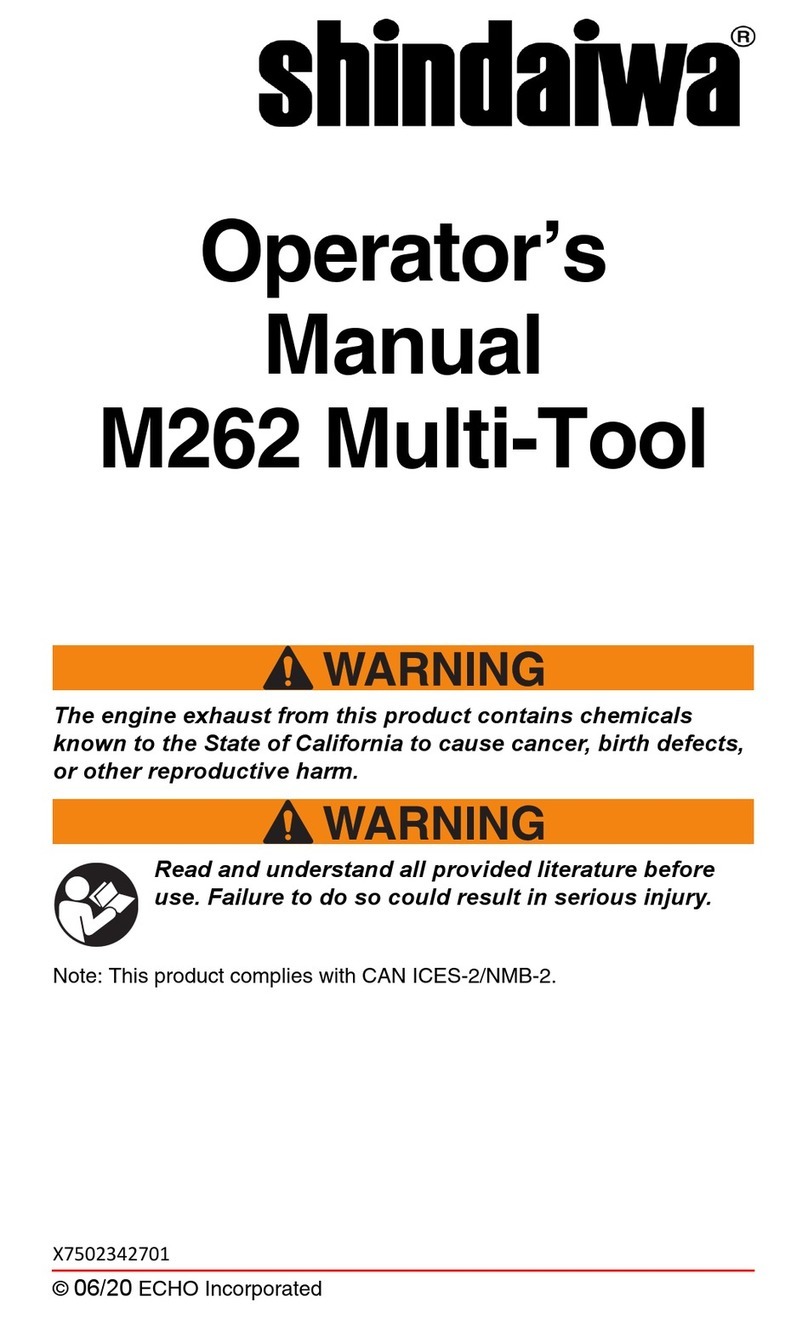
Shindaiwa
Shindaiwa M262 Operator's manual
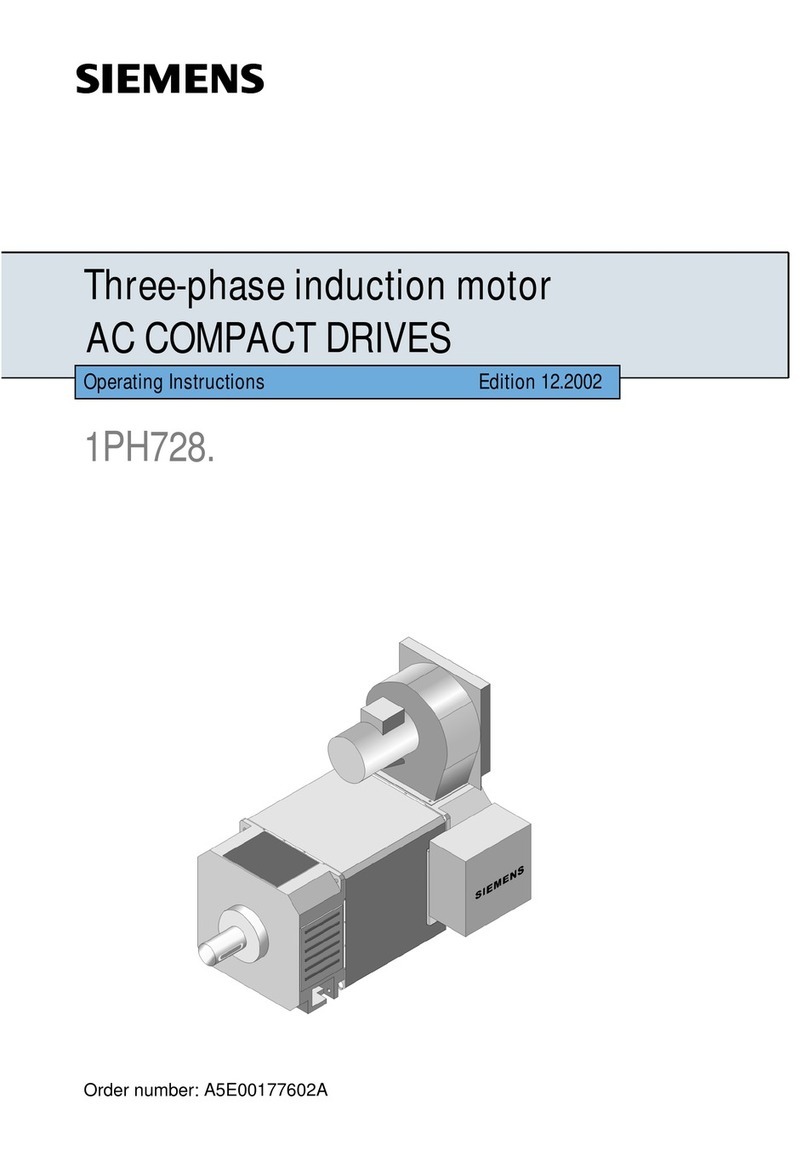
Siemens
Siemens 1PH728 operating instructions
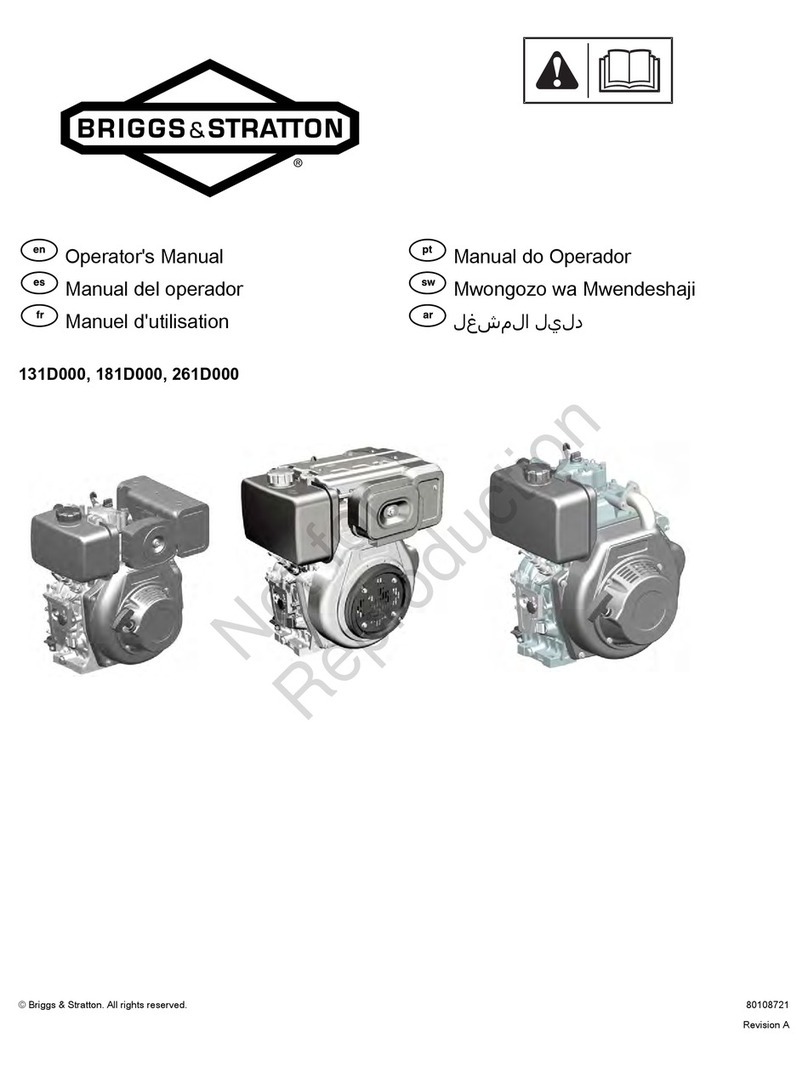
Briggs & Stratton
Briggs & Stratton 131D000 Operator's manual
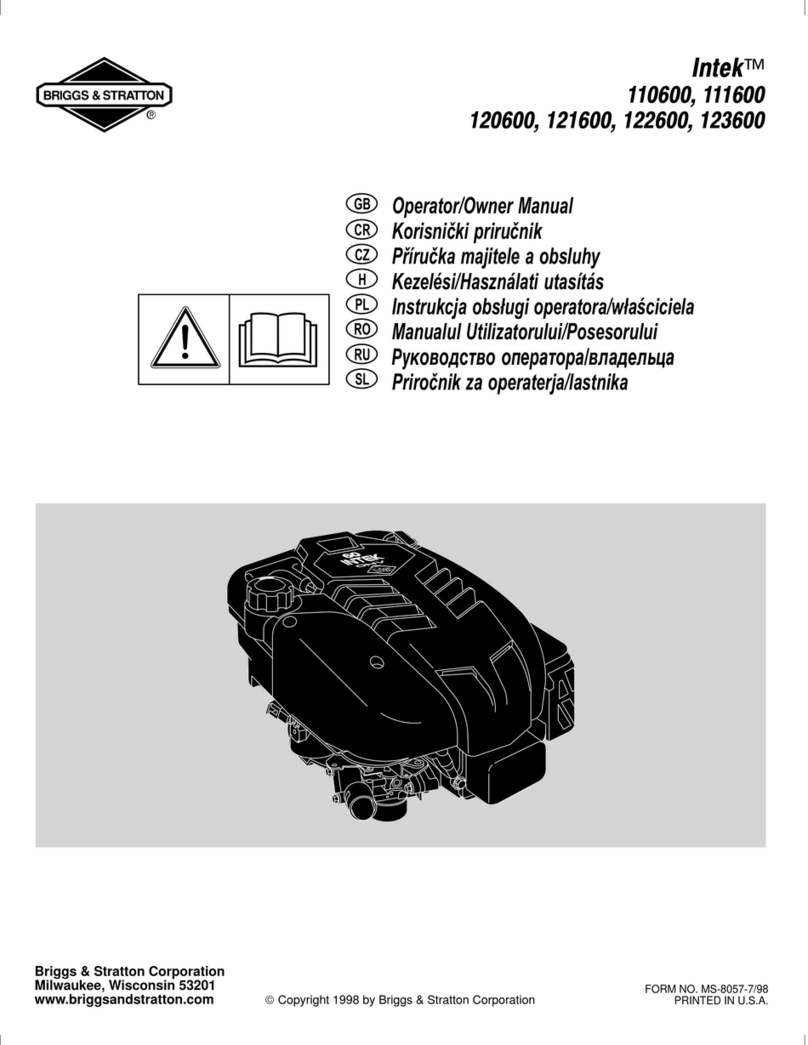
Briggs & Stratton
Briggs & Stratton Intek 110600 Operation and owner's manual
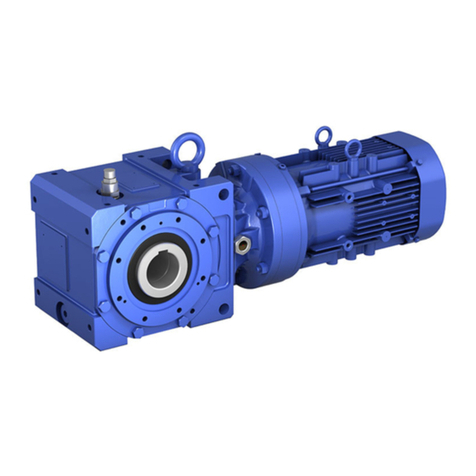
Sumitomo
Sumitomo BUDDYBOX operating manual
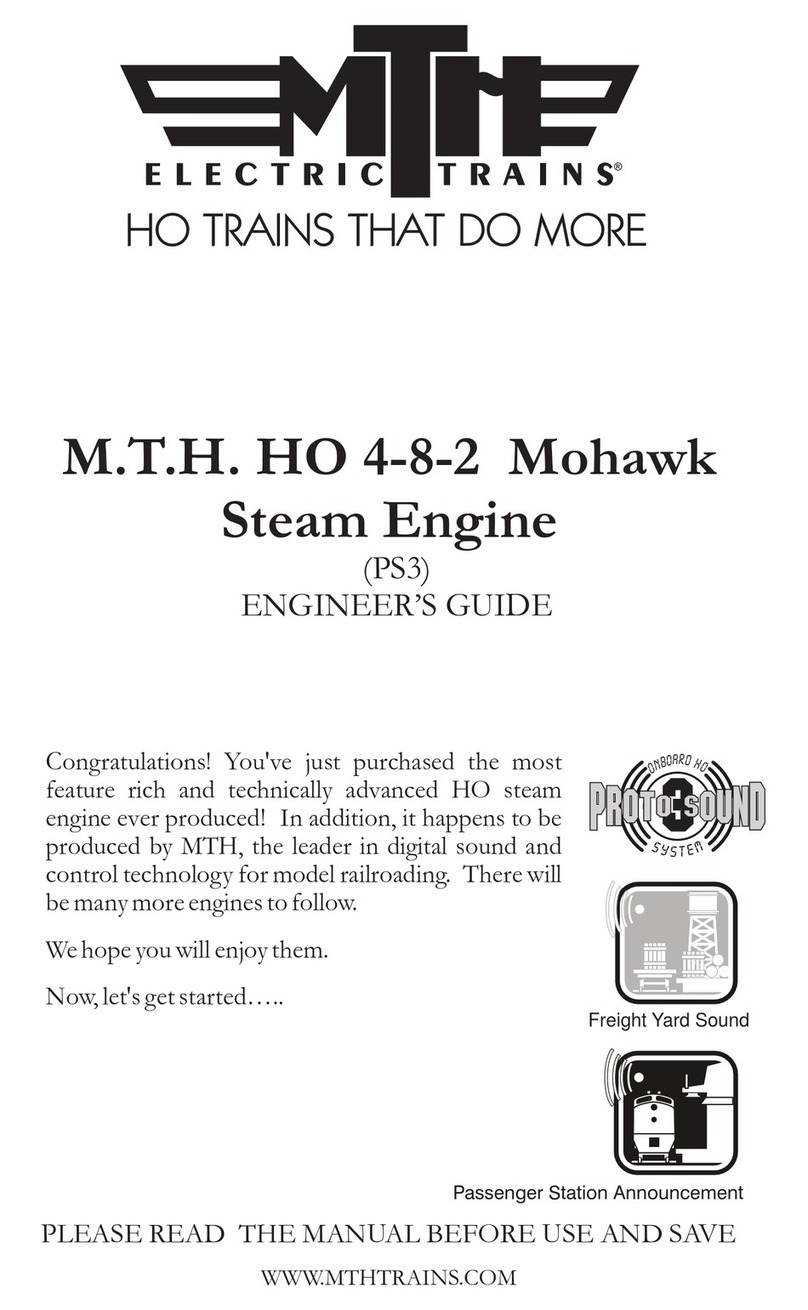
MTHTrains
MTHTrains HO 4-8-2 Mohawk Engineer's guide

